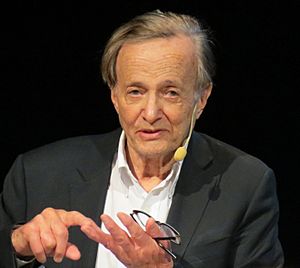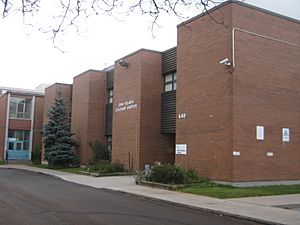John Polanyi facts for kids
Quick facts for kids
John Polanyi
|
|
|---|---|

Polanyi in 2019
|
|
| Born |
John Charles Polanyi
23 January 1929 |
| Nationality | Canadian |
| Alma mater | University of Manchester |
| Known for | Chemical kinetics Reaction dynamics |
| Spouse(s) |
Anne Davidson
(m. 1958; died 2013) |
| Children | 2 |
| Parent(s) |
|
| Relatives |
|
| Awards |
|
| Scientific career | |
| Institutions | University of Toronto |
John Charles Polanyi (born January 23, 1929) is a famous Canadian chemist. He was born in Germany. In 1986, he won the Nobel Prize in Chemistry. This award was for his important work in chemical kinetics, which is the study of how fast chemical reactions happen.
Polanyi's family moved from Germany to the United Kingdom in 1933. He later studied at the University of Manchester and earned his PhD in 1952. After that, he did more research in Canada and the United States. In 1956, he started working at the University of Toronto. He is still a Professor Emeritus there today. Besides his science work, Polanyi is also very active in public discussions. He often talks about science and how to prevent nuclear weapons. His father, Michael Polanyi, was also a well-known chemist and thinker.
Contents
Early Life and Education
John Polanyi's family moved from Germany to Britain in 1933. They left partly because of the persecution of Jewish people. During World War II, when he was 11, his father sent him to Canada for three years. This was to keep him safe from German bombings. While in Toronto, he went to the University of Toronto Schools.
After returning to Britain, Polanyi finished high school. He then went to Manchester University. He earned his first degree in 1949 and his PhD in 1952. Even though he studied science, he once thought about becoming a poet. After his PhD, he did more research in Canada and at Princeton University in the United States.
Academic Career
John Polanyi began working at the University of Toronto in 1956. He quickly became a full professor by 1962. In 1975, he received the special title of University Professor. He has held this honorary title ever since.
Understanding Chemical Reactions
Polanyi's early studies focused on measuring how strong chemical bonds are. For most of his career, his research has been about reaction dynamics. This means he tries to figure out exactly how chemical reactions work. He also studies what chemicals are like during the moment they change.
One of his big discoveries was about something called chemiluminescence. This is the light that a molecule gives off when it is in an excited state. He and his students first published this work in 1958.
Modern Research Methods
After winning the Nobel Prize in 1986, Polanyi's research methods changed. He learned about scanning tunneling microscopy (STM) from other Nobel winners. This technology lets scientists see chemical reactions happening on a very tiny scale. His lab at the University of Toronto now uses these special microscopes. They help him study how atoms and molecules behave during reactions. This kind of research is very important for new technologies like nanotechnology.
Beyond the Lab: Public Involvement
John Polanyi has always cared about the world around him. Even as a student, he was interested in politics. In the 1950s, he started getting involved in public issues. He was especially concerned about nuclear weapons.
He helped start Canada's Pugwash group in 1960. This group is part of a global movement that won the Nobel Peace Prize in 1995. Their main goal is to reduce conflicts and find solutions to global problems. Polanyi also supports "pure" science, which means research done just to gain knowledge. He often speaks about social justice, peace, and stopping nuclear weapons. He also writes articles for newspapers about science and public policy.
Awards and Recognition
The Nobel Prize
John Polanyi won the 1986 Nobel Prize in Chemistry. He shared it with two other scientists, Dudley Herschbach and Yuan T. Lee. They were honored for their work on how chemical reactions happen. Polanyi's part was developing a method called infrared chemiluminescence. This method helps measure the faint infrared light given off by new molecules. This shows how energy is released during a chemical reaction.
Other Honors
Polanyi has received many other awards throughout his career. He became a Fellow of the Royal Society in 1971. He was also made an Officer of the Order of Canada in 1974 and later a Companion in 1979. Some of his other awards include the Wolf Prize in Chemistry in 1982 and the Royal Medal in 1989. In 2007, he received the Gerhard Herzberg Canada Gold Medal for Science and Engineering.
He has also received over 30 honorary degrees from universities around the world. In 2011, Polanyi was featured on a Canada Post postage stamp. This stamp celebrated the International Year of Chemistry. In 2022, he received the Andrei Sakharov Prize. This award recognized his many years of working for a world free of nuclear weapons. It also honored his efforts to protect human rights and promote the importance of science.
Legacy and Impact
In honor of Polanyi's Nobel Prize, the Ontario government created the "John Charles Polanyi Prizes." These prizes are given to young researchers in Ontario. They help support new scientists in fields like physics, chemistry, and medicine.
Canada's Natural Sciences and Engineering Research Council (NSERC) also created the John C. Polanyi Award. This award recognizes Canadian researchers whose work has led to a major scientific breakthrough.
Polanyi has published over 250 scientific papers since 1953. He has also written more than 100 articles about policy and the impact of science on society. In 2010, a school in Toronto was renamed the John Polanyi Collegiate Institute in his honor.
Personal Life
John Polanyi was born in Berlin, Germany. His father, Michael Polanyi, was a scientist. His uncle, Karl Polanyi, was a well-known economist.
In 1958, Polanyi married Anne Ferrar Davidson. They had two children: a daughter named Margaret and a son named Michael. Margaret is a journalist, and Michael is a political scientist. Polanyi is currently married to artist Brenda Bury. When he is not working on science or policy, Polanyi enjoys art, literature, and poetry. He used to enjoy white water canoeing and now enjoys walking and skiing.
See also
 In Spanish: John C. Polanyi para niños
In Spanish: John C. Polanyi para niños
- Chemical laser
- The Martians (scientists)
- List of Jewish Nobel laureates


